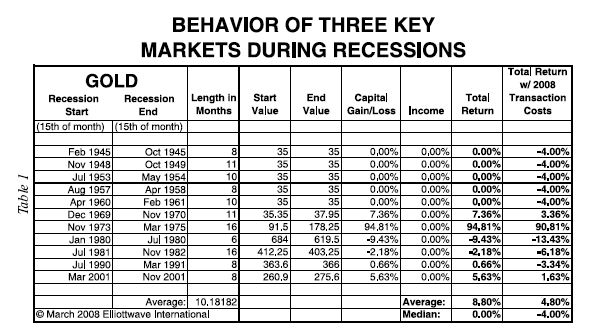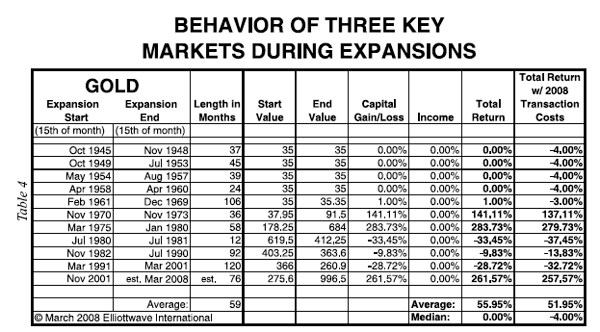Gold: Best Supporting Role In Economic Downturns? Think Again
Gold’s safe-haven status is based on hype, not history
By Nico Isaac
As I sat down to watch the Oscar pre-show on Sunday night, March 7, one word was repeatedly used to describe the celebrity starlets and their designer duds: GOLD. Gold bustiers and gold lame skirts, shiny gun-metal dresses and glittery sequined gowns all basking in the golden shadow of the final golden statue.
Everywhere you look, from the Red Carpet to Wall Street, gold is definitely in “fashion.” As for why, one word comes to mind: safe-haven. See, according to the mainstream financial experts, the more unstable the global economy, the greater the appeal for the precious metal.
And, with a staggering 17% unemployment rate in the United States, alongside slumping real estate sales, Eurozone weakness, the Greece debt debacle, and so on — the only thing going up is gold’s supposed disaster premium. Here, take these recent news items for example:
- “Bullion Sales Hit Record In Stampede To Safety.” (Financial Times)
- “Gold Ticks Higher On Safe Haven Buying. The risk trade is resuming.” (AP)
- “Gold Rose to 6 ½ Week Highs as the metal benefits from fears over financial instability in general. The market is looking for some security with gold.” (Reuters)
- “Gold Rush: This is a new round of safe haven buying.” (Bloomberg)
There’s just one problem: The correlation between a falling economy AND rising gold prices is based solely on hype, NOT history.
Download Robert Prechter’s FREE 40-Page Gold and Silver eBook. Is gold a simple buy-and-hold at today’s prices? The independent insights in this valuable ebook deliver Prechter’s complete analysis and help you decide how to – and how not to – incorporate gold and silver successfully into your own investment strategy. Learn more, and download your Gold and Silver eBook here.
Case in point: In the March 2008 Elliott Wave Theorist (republished in his 40-page Gold and Silver eBook), Elliott Wave International President Bob Prechter presents an indisputable case AGAINST the safe-haven status of gold.
 |
The first piece of evidence:
The above table showing gold’s performance during the
11 officially recognized recessions beginning in 1945.
Prechter also plotted the Dow Jones Industrial Average into the same period and made this startling discovery: The average total return for the Dow during recessions since 1945 is 6.89%. Taking into account modern transaction costs, the Dow actually beats gold with a 6.87% return.
 |
The most powerful myth-debunking punch of all,
though, came via the second chart of gold’s performance –
this time during periods of financial growth.
In Prechter’s own words:
“All huge gains in gold have come while the economy was expanding… The idea that gold reliably rises during recessions and depressions is wrong. In fact, like most such passionately accepted lore, it’s backwards.”
Now, this doesn’t mean that you shouldn’t own gold in a financial crisis. On the contrary: In chapter 22 of his Wall Street Journal business bestseller,Conquer the Crash, Prechter lists 5 reasons why “you should buy gold and silver anyway.” Gold is “real money,” after all! It’s just that, despite widespread beliefs to the contrary, you shouldn’t expect “huge gains in gold” when the economy contracts.
Download Robert Prechter’s FREE 40-Page Gold and Silver eBook. Is gold a simple buy-and-hold at today’s prices? The independent insights in this valuable ebook deliver Prechter’s complete analysis and help you decide how to – and how not to – incorporate gold and silver successfully into your own investment strategy. Learn more, and download your Gold and Silver eBook here.
Nico Isaac writes for Elliott Wave International, a market forecasting and technical analysis firm.
Does Gold Always Go Up in Recessions and Depressions?
June 4, 2009
By Robert Prechter, CMT
The following article is adapted from a brand-new eBook on gold and silver published by Robert Prechter, founder and CEO of the technical analysis and research firm Elliott Wave International. For the rest of this revealing 40-page eBook, download it for free here.
I have often read, “Gold always goes up in recessions and depressions.” Is it true? Should you own gold because you think the economy is tanking? Whenever we hear some claim like this, we always do the same thing: We look at the data.
The first thing to point out is that gold did not make a nickel of U.S. money for anyone in any of the recessions and depressions from 1792, when the gold-based dollar was adopted, through 1969, a period of 177 years. Well, to be precise, there was a change in the valuation in 1900, when Congress changed the dollar’s value from 24.75 grains of gold, the amount established in 1792, to 23.22 grains, a devaluation of just six percent total over 108 years. The government did raise the fixed price from $20.67/oz. to $35/oz. in 1934, but that action occurred during an economic expansion, not during the Depression. In 1968, gold finally began trading away from the government’s fixed price. Even then, it slipped to a lower price of $34.95 on January 16 and 19, 1970. So the idea that gold always goes up in recessions and depressions is already shown to be wrong. It did not go up in terms of dollars in any of the (estimated) 35 recessions or three depressions during that period.
What almost always does happen during economic contractions is that the value of whatever people use as money goes up as prices for goods and services fall. When gold is used as money, its value in terms of goods and services goes up. But gold can’t go up in dollar terms when gold and dollars are equated. So no one “makes money” holding gold under these conditions. It is a fine point: What tends to go up relative to goods and services during economic contractions is money, and when gold is officially money, that’s how it behaves. What we want to know is how gold behaves in recessions and depressions when it is not officially accepted as money.
Many gold bugs say that because gold was a good investment during the Great Depression, it is a “deflation hedge.” We addressed this topic in At the Crest of a Tidal Wave (1995, p.357) and Conquer the Crash (2002, pp. 208-209). At the time, government fixed gold’s price, so it didn’t go up or down relative to dollars. Gold was a haven during that time, the same as the dollar was, since they were equated by law. But gold served as a haven because its price was fixed while everything else was crashing in price during the period of deflation. Gold bugs like to claim that gold would have gone up during that period had it not been fixed, but the crashing dollar prices for all other things suggest that in a free market gold, too, would have fallen. It would have fallen, however, from a higher level given the inflation of 1914-1929 following the creation of the Fed. So gold became worth more in dollar terms than it was in 1913, which is why it began flowing out of the country. In 1934, the government finally recognized the new reality by raising gold’s fixed price. Since 1970, markets have been in a large version of 1914-1930, except that gold has been allowed to float, so we can clearly see its inflation-related, pre-depression gains.
Observe that gold’s price remained the same for a Fibonacci 21 years after the Fed was created in 1913; it was revalued in 1934. [Ed. Note: For a full chapter on Fibonacci time considerations for gold, download the 40-page Gold and Silver eBook.] Then it held that value for 35 (a Fibonacci 34 + 1) years, through 1969. So aside from the revaluation of 1934, the inability to make money holding gold during recessions, depressions, or any time at all save for the day of the revaluation in 1934 held fast for 56 (a Fibonacci 55 + 1) years following the creation of the Fed. So even after Congress created the central bank, no one made money holding gold in a recession or depression for two generations.
In 1970, things changed dramatically. Investors lost interest in stocks and preferred owning gold instead, for a period of ten years. The same change occurred again in 2001, and so far it has lasted seven years. But, as we will see, recession had nothing to do with either of these periods of explosive price gain in the precious metals.
The period of time one chooses to collect data can make a huge difference to the outcome of a statistical study. If we were to show the entire track record from 1792, gold would show almost no movement on average during economic contractions. If we were to take only 1969 to the present, it would show much more fluctuation. To give a fairly balanced picture, combining some history with the entire modern, wild-gold era, I asked my colleague Dave Allman to compile statistics beginning at the end of World War II. This is what most economists do, because they believe “modern finance” began at that time and that things have been “normal” since then. It’s also when many data series begin. So our study fits the norm that most economists use. It also provides results entirely from the Fed era, making it relevant to current structural conditions.
[Ed. note: To study the six tables revealing gold’s performance record vs. stocks and T-notes since WWII, download the 40-page Gold and Silver eBook.]
Table 1 shows the performance of gold during the 11 officially recognized recessions beginning in 1945. Although one could make a case for different start times, we took the 15th of the starting month and the 15th of the ending month as times to record the price of gold. The results speak for themselves. Even though it is accepted throughout most of the gold-bug community that gold rises in bad economic times, Table 1 shows that such is not the case.
The only reason that the average gain for gold shows a positive number at all is that gold rose significantly during one of these recessions, that of 11/73-3/75. The average gain for all ten of the other recessions is 0.16 percent, almost exactly zero. The median for all 11 recessions is also zero. If we omit the five recessions during which the price of gold was fixed, the median gain is 3.09 percent.
For long-term forecasts and more in-depth, historical analysis for precious metals, including the six revealing tables mentioned in this article, download Prechter’s FREE 40-page eBook on Gold and Silver.
Robert Prechter, Chartered Market Technician, is the founder and CEO of Elliott Wave International, author of Wall Street best-sellers Conquer the Crashand Elliott Wave Principle and editor of The Elliott Wave Theorist monthly market letter since 1979.